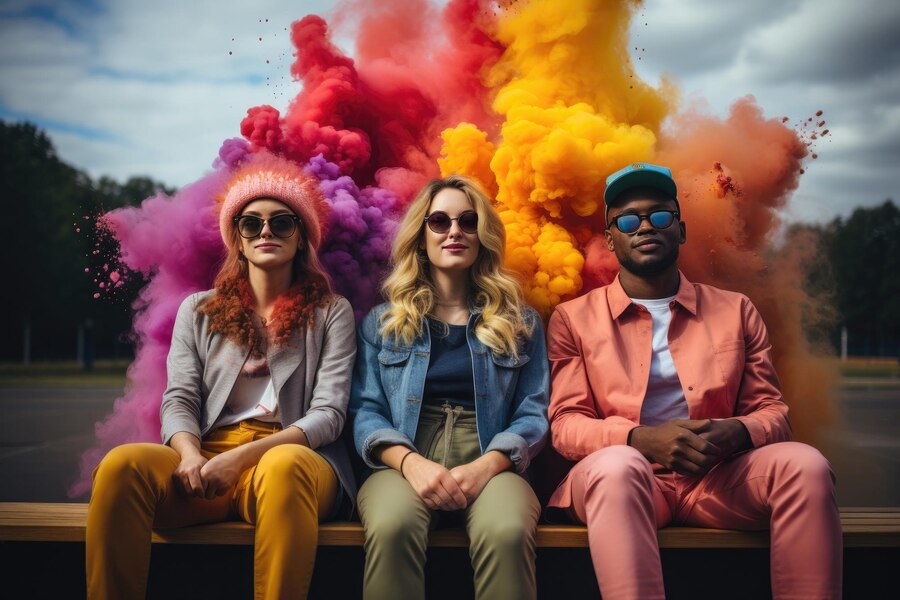Introduction
Colors are an integral part of our daily lives, influencing our emotions, behaviors, and perceptions in ways we often don’t realize. From the clothes we wear to the spaces we inhabit, colors have a profound impact on our moods and mental well-being. This article will delve into the concept of color vibes, exploring how different colors affect us and how we can harness their power to improve various aspects of our lives.
The Psychology of Color
What is Color Psychology?
Color psychology is the study of how colors affect human behavior and emotions. It examines the ways in which different hues can evoke specific responses, from feelings of calm and relaxation to excitement and energy.
Historical Perspective
Historically, colors have held significant meaning in various cultures. For instance, ancient Egyptians used colors in their art and rituals to convey different emotions and messages. Similarly, in Chinese culture, colors are associated with different elements and directions, each carrying its own symbolism and significance.
Understanding Color Vibes
What are Color Vibes?
Color vibes refer to the emotional and psychological responses that different colors evoke in us. These vibes can influence our mood, energy levels, and even our decisions. Understanding color vibes can help us create environments that promote positive feelings and well-being.
The Science Behind Color Perception
Our perception of color is influenced by both biological and psychological factors. The way our eyes and brains process light wavelengths plays a crucial role in how we perceive colors. Additionally, personal experiences and cultural background also shape our emotional responses to different colors.
The Impact of Different Colors
Warm Colors
Red
Red is a powerful and dynamic color often associated with energy, passion, and excitement. It can stimulate feelings of love and warmth but can also evoke strong emotions like anger and intensity.
Orange
Orange combines the energy of red and the happiness of yellow. It is often associated with enthusiasm, creativity, and encouragement. Orange can create a sense of warmth and joy, making it a great color for social spaces.
Yellow
Yellow is the color of sunshine and is often linked to happiness, optimism, and positivity. It can boost mental clarity and focus, but too much yellow can sometimes lead to feelings of anxiety.
Cool Colors
Blue
Blue is a calming and serene color that promotes relaxation and peace. It is often associated with stability, trust, and calmness. Blue is an excellent choice for spaces where you want to create a tranquil atmosphere.
Green
Green is the color of nature and is linked to feelings of balance, harmony, and growth. It can have a soothing effect on the mind and body, making it ideal for environments where relaxation and rejuvenation are desired.
Purple
Purple combines the calm stability of blue and the fierce energy of red. It is often associated with luxury, creativity, and spirituality. Purple can inspire imagination and creativity, making it a great choice for artistic spaces.
Neutral Colors
White
White symbolizes purity, cleanliness, and simplicity. It can create a sense of space and openness but can also feel stark and sterile if overused.
Black
Black is a powerful and sophisticated color often associated with elegance, mystery, and strength. It can add depth and contrast to a space but should be used sparingly to avoid creating a gloomy atmosphere.
Gray
Gray is a neutral and balanced color that can create a sense of calm and sophistication. It is often used in modern and minimalist designs but can sometimes feel dull if not paired with more vibrant colors.
Using Color Vibes in Everyday Life
In Home Decor
Creating Ambiance
Understanding color vibes can help you choose the right colors for different rooms in your home. For example, using calming colors like blue and green in bedrooms can promote relaxation and restful sleep, while vibrant colors like red and orange in living rooms can create an energetic and welcoming atmosphere.
Enhancing Productivity
In workspaces, colors like yellow and green can boost creativity and productivity. Incorporating these colors in your office decor can help you stay focused and motivated.
In Fashion
Expressing Personality
The colors you wear can reflect your personality and mood. Bright, bold colors like red and orange can convey confidence and energy, while softer hues like pastels can evoke a sense of calm and approachability.
Dressing for the Occasion
Different occasions call for different color choices. For instance, wearing blue or black for formal events can convey professionalism and elegance, while choosing lighter, more vibrant colors for casual outings can create a fun and relaxed vibe.
In Marketing and Branding
Creating Brand Identity
Brands use colors to create a unique identity and connect with their target audience. For example, red is often used in fast-food branding to stimulate appetite, while green is commonly used by eco-friendly brands to convey sustainability and health.
Influencing Consumer Behavior
Colors can significantly impact consumer behavior and purchasing decisions. By understanding color psychology, marketers can design packaging and advertisements that attract attention and evoke the desired emotional response.
Conclusion
Color vibes play a crucial role in our lives, influencing our emotions, behaviors, and perceptions in various ways. By understanding the power of colors and how they affect us, we can make more informed choices in our home decor, fashion, and even marketing strategies. Harnessing the right color vibes can enhance our well-being, boost productivity, and create environments that reflect our personalities and values.
FAQs
What are color vibes?
Color vibes refer to the emotional and psychological responses that different colors evoke in us. They influence our mood, energy levels, and decisions.
How do colors affect our emotions?
Colors can evoke specific emotions and responses. For example, red can stimulate excitement and passion, while blue can promote relaxation and calmness.
How can I use color vibes in my home decor?
Understanding color vibes can help you choose colors that create the desired ambiance in different rooms. For example, calming colors in bedrooms can promote relaxation, while vibrant colors in living areas can create an energetic atmosphere.
Why is color important in marketing and branding?
Colors help create a brand identity and influence consumer behavior. By using the right colors, brands can attract attention, convey their values, and evoke desired emotional responses from their target audience.
Can color preferences vary between individuals?
Yes, color preferences can vary based on personal experiences, cultural background, and individual differences. What evokes a positive response in one person might not have the same effect on another.







